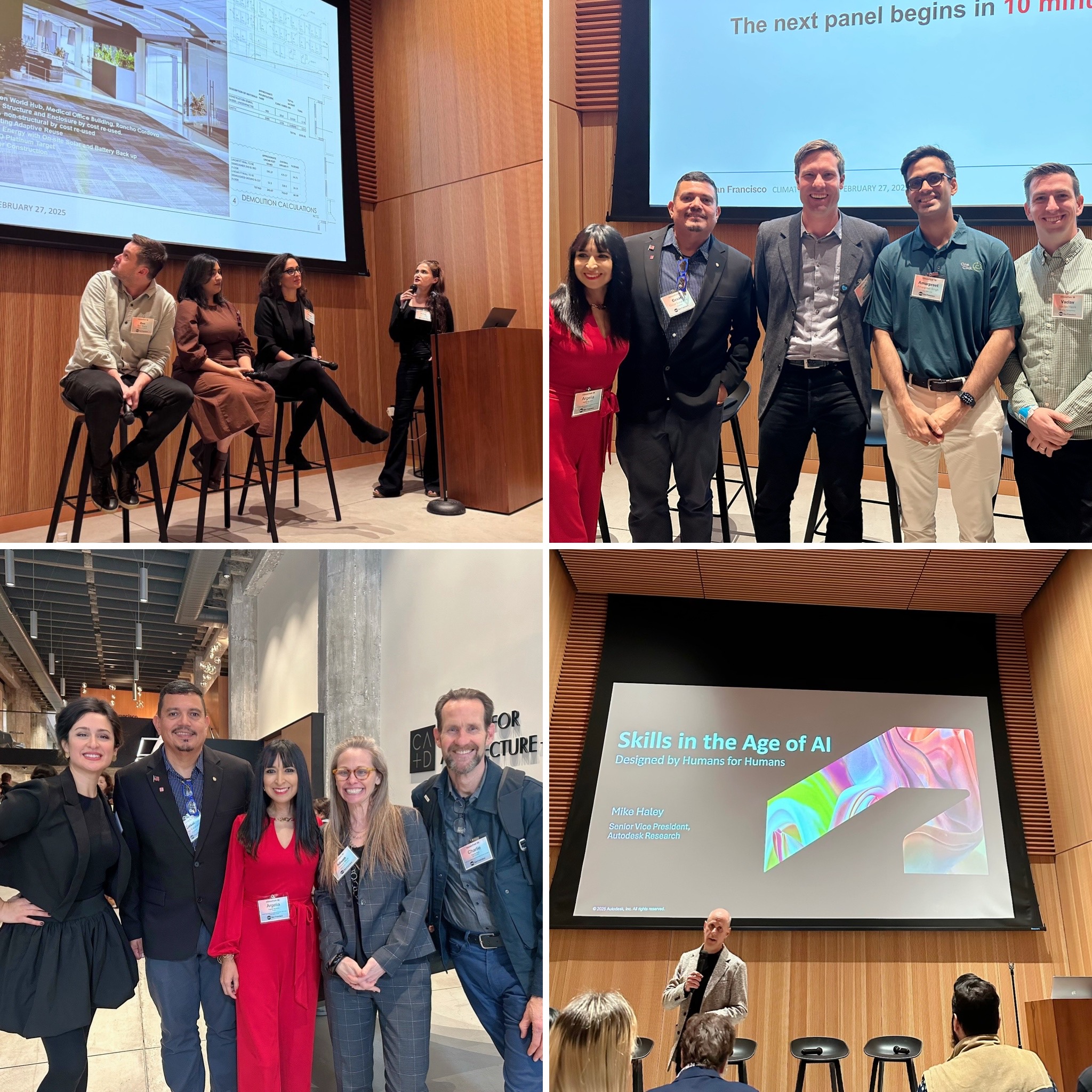Takeaways from ClimateTech '25: Technologies for Action
April 7, 2025At ClimateTech '25: Technologies for Action, industry leaders gathered to discuss the tools and processes driving change in reducing the building industry's carbon footprint. Hosted at the Center for Architecture + Design in San Francisco, the symposium brought together AEC experts in a day of engaging discussions.
The event kicked off with keynote speaker Mike Haley, SVP of Research at Autodesk, who shared how AI is catalyzing an “age of abundant creativity." As practitioners shift beyond traditional keyboard and mouse inputs to intuitive modalities like voice and drawing, we’re unlocking new possibilities. Mike shared how AI is already transforming biotech, architecture, finance, manufacturing — with tools like Bernini, Gearformer, and Forma. The development of generative tools is enabling work to be completed faster and more efficiently, freeing up time for people to shift their focus, enabling more creativity.
Argelia Barcena, Gensler Chair of AIASF Technology in Architectural Practice, moderated the first panel centered around carbon accounting. Jack Rusk of C.Scale, Vaclav Hasik of Building Transparency, Cesar Escalante of Autodesk, and Amarpreet Singh of One Click LCA discussed the tools they’ve used in practice.
Jack Rusk, Co-Founder at C.Scale, emphasized the necessity of prioritizing sustainability from the very start of the design process. The biggest impact happens before a project breaks ground, ensuring designers, contractors, and all stakeholders are aligned with the right tools and a clear carbon vision from day one. Teams need to fill in the gaps throughout a project’s lifecycle by enabling carbon reduction strategies like: building less, reusing existing structures, switching structural systems, low-carbon materials, electrification, and carbon-storing landscapes.

The development of cities and buildings over the next few decades means that materials will be the dominant source of carbon dioxide emissions. Amarpreet Singh with One Click LCA explained how climate impact is biggest at work in the construction industry, where carbon accounting can be performed at multiple points from early phase design to specification to project tracking. The highest potential for impact, and also the least expensive, happens early on during the site selection and concept design phases.


The second panel, moderated by Alison Muh, Assoc. AIA, focused on climate and code and regulations. Eric Stimmel of SOM, Emi LaFountain of Turner Construction, and Sean Quinn of HOK discussed evolving carbon codes and how firms can start to better integrate carbon reduction into practice.
In the state of California, CALGreen is the Green Building Standards Code, and sets the requirements for sustainable construction practices in areas like energy efficiency, water conservation, and environmental quality. Beyond this Code, developers tend to look at economics over environmental implications; in order to impact change, cities need to start changing policy mandate requirements.
Niknaz Aftahi, Founder of aec+tech, moderated a panel on how firms of all sizes can integrate low-carbon design, the circular economy, and climate-focused strategies into their work. We heard from Hafsa Burt of hb+a architects, Pragya Gupta of NBBJ, and Ben Welty of Feldman Architecture on how their teams are:
- Developing dashboards to model product design choices
- Creating databases to establish carbon emissions baselines
- Implementing carbon budgets to guide decision-making


Architecture firms are building carbon accounting solutions and tools from scratch, allowing for customization and integration into their specific sustainable design core processes. Ben Welty spoke about his firm’s use of tools like ClimateStudio and Tally to run analyses of projects. In 2024, 100% of construction projects at Feldman had an established carbon budget.
The final panelists discussed material circularity and climate. Moderated by Kathryn Soter of Good Future Design Alliance; Garrett Benisch of Bioforcetech, Marcus Hopper of Gensler, and Frances Yang of ARUP discussed how architects and engineers can create a more circular built environment. Circularity is when materials never become waste, keeping materials in circulation for as long as possible. 600,000,000 tons of construction waste is generated every year with 90% of that from demolition. It’s vital to reduce demolition, design for disassembly, and explore healthier materials.
Chris Field, Director of Stanford Woods Institute for the Environment, closed out the day with a discussion on the urgent need for climate change solutions. He emphasized the need to reduce emissions from electricity as a starting point, and advised on four ways individuals can help: through voting for leaders who support a global climate agenda, investing in companies who make sustainable choices, consumption choices, and building less.

Here are three of my key takeaways from the event:
- Think about the end, in the beginning. Create a roadmap as those early decisions will have a huge impact on material choices, reduced changes, and team partnership on sustainability goals.
- Construction activities, both demolition and building, have a huge carbon impact. Shift away from carbon heavy materials like steel and concrete, and focus on building less, prioritizing circularity and re-use.
- Tools are continuously being developed to create efficiency in the built environment. It’s vital to keep learning to find the technology that supports specific needs.
The conversations at the Design Technology Symposium reinforced that emerging technology, early collaboration, policy change, and building less are key to decarbonizing the construction industry. Progress on these fronts will continue to drive sustainability in the built environment.

About the Author
Julie Chau is a Senior Project Manager and Workplace Strategist at Athena Blue Global. She is passionate about creating functional and inspiring spacesfor people, fostering collaboration and well-being. Previously, she worked at LinkedIn as a Workplace Design Manager, shaping workspaces and employee experiencesacross North America. She holds an M.Arch from UC Berkeley and a B.S. Architecture from the University of Michigan. She’s currently based in the SanFrancisco Bay Area.